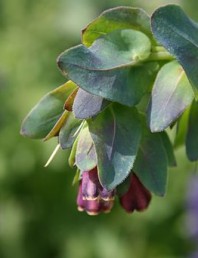This weekend The Guardian was the only national newspaper to report the results of this year’s National Poetry Competition. The winning entry was by a woman called Linda French and the poem was called Bernard and Cerinthe (click the link to read it!). A plant-inspired poem, it depicts a man’s (Bernard) liking for Cerinthe, and was chosen for its ‘vivid imagery and linguistic wit’.
The Guardian’s reporting of this story led Plant Curator to wonder what plant French is actually referring to. In her account on the Poetry Society website, the plant in question is written as Cerinthe major ‘Purpurascens’. In plant naming conventions Cerinthe denotes the genus, major the species epithet (which together is the species name) and ‘Purpurascens’, because in speech marks, tells us it is a cultivar (i.e. a plant that has arisen in cultivation rather than the wild). Yet when The Guardian reported the story they wrote the name as Cerinthe major Purpurascens, flaunting the rules of nomenclature. Species name Cerinthe major is not italicised, but Purpurascens is, plus they have capitalised it. This is neither one thing or another – the italics could indicate a taxon (a classification of species) lower than species such as a subspecies or variety – yet, if that were the case it would be convention to have the whole thing italicised and an abbreviation of subsp. or var. before the word Purpurascens, and no capitalisation. So who knows what got into The Guardian. Perhaps the science and gardening departments were having a weekend off. However, the ambiguity of it all led Plant Curator to consult the experts.
Plant Curator first checked the Royal Horticultural Society Database and it lists Cerinthe major ‘Purpurascens’ as a valid cultivar, but in its Plant Selector it also names Cerinthe major var. purpurascens, all in italics, as a synonym of this plant. Writing it in this way we can only assume they are saying that the wild occurring plant is the same as the cultivar, or else they think people have confused it as such. Huh.
Plant Curator then checked the Catalogue of Life and The Plant List (the wild plant authorities), both of which have Cerinthe major subsp. purpurascens (Boiss.) Selvi & L.Cecchi. as an accepted name, and Cerinthe major var. purpurascens as a synonym of that name. A quick check on the International Plant Names Index (IPNI for short) tells us the dates when these different taxonomic treatments occured. Before acquiring its current accepted name, it was called Cerinthe major L. var. purpurascens Boiss. The L. tells us Linnaeus named the species Cerinthe major some time in the 18th Century. Then in 1941 Boiss. came along and decided there was a different variety (note not a cultivated variety!) of the plant occurring in the wild. IPNI tells us the distribution of that variety to be in Spain. Then in 2009 Selvi & L.Cecchi decided that Boiss was mistaken and it was not a variety but in fact a subspecies.
All very interesting, but it still doesn’t tell us how it became a cultivar with the name Cerinthe major ‘Purpurascens’, or whether it is the same (looks like it) or a different plant to the wild one. Why is the cultivar name needed? Have they done something to the subspecies to make it more desirable to horticulture, or are some cultivars just wild occurring plants?
Today, the international naming rules for cultivars state you must only quote cultivar names within single inverted commas, begin them with a capital letter and use modern rather than Latin names. Hence Purpurascens would not be used. Hallelujah. In the meantime let’s appreciate a great poem inspired by a great subject and hope that a wiser plant expert will comment on this post and enlighten us further.
Image copyright: Sten [CC-BY-SA-3.0-2.5-2.0-1.0 or GFDL], via Wikimedia Commons
